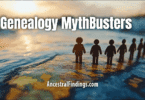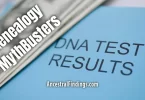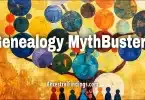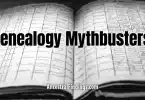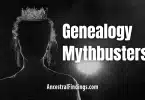One of the most tempting shortcuts in genealogy is the idea of the “master family tree.” A single, giant, authoritative tree where everyone is already linked, all the names and dates are correct, and all you have to do is plug your family into the right spot.
You’ll hear this myth from new researchers, see it implied in online ads, and sometimes even find it in casual conversations: “Isn’t there one big tree somewhere that already has all of this figured out?”
It’s a nice idea. Imagine logging in, clicking a few buttons, and instantly tracing your family back ten generations. But here’s the truth: a flawless, universal master tree does not exist, and probably never will.
That doesn’t mean there aren’t shared trees online. It just means they are often riddled with errors, duplications, and contradictions. Today we’ll dig into where the myth came from, how shared trees can be both helpful and dangerous, and what you should do instead to build a reliable family history.
Why the Master Tree Myth Took Hold
Part of the problem comes from the way genealogy websites market themselves. Sites like Ancestry, FamilySearch, Geni, and MyHeritage all encourage users to share their trees. Some even connect them into giant “collaborative trees.”
The pitch sounds amazing. Thousands of researchers pooling their work into one master file. But while this can be helpful, it also introduces serious issues. When one person attaches the wrong ancestor, that mistake spreads. And once an error is copied enough times, it starts to look like fact.
The myth is reinforced by family stories. “Your cousin already has the whole tree.” Or “Grandma’s book from the 1970s traced us back to the Mayflower.” These give the impression that somewhere, out there, someone has already done all the work, and all you need to do is copy it down.
The Reality of Shared Trees
Let’s be honest: shared family trees can be useful starting points. They can point you toward cousins who have researched the same line. They can save time by suggesting sources you might not have thought to check. But they are never perfect.
Here are a few of the problems:
- Duplicates: The same ancestor may be entered five different ways by five different people.
- Wrong connections: A John Smith in Kentucky gets mixed up with a John Smith in Virginia. Suddenly entire branches are merged incorrectly.
- Unsourced claims: Dates, places, and relationships often appear without a single document to back them up.
- Copy-paste errors: Mistakes spread when people blindly import entire trees from others.
One famous example is the supposed descent of countless Americans from Charlemagne. While it is technically possible, the specific trees people share are often riddled with gaps, assumptions, and leaps of faith.
A Case Study in Tree Trouble
A researcher once contacted me about her “royal lineage.” She had found a master tree online that traced her line back to medieval England. The problem was that the tree jumped four generations with no documents, connecting her 18th-century farmer in Virginia to a 14th-century knight in Yorkshire. When we checked the records, there was no evidence of that connection. The “master tree” had made a leap, and hundreds of other users copied it, assuming it was correct.
This is the danger of the master tree myth. Once errors take root, they get repeated, cited, and believed.
Why a Universal Tree is Impossible
Even if every genealogist agreed to build one single tree, it would still be riddled with contradictions. Here’s why:
- Incomplete records: Not every family left a paper trail. Some lines will always end in mystery.
- Conflicting evidence: Two documents might give different birthplaces or parents. Which one is right?
- Cultural differences: Naming traditions, adoptions, and non-traditional families often defy neat tree structures.
- Errors in the past: Old genealogies sometimes invented connections to make families sound more prestigious. Those errors echo forward.
Genealogy is detective work. It requires weighing evidence, making judgments, and sometimes living with uncertainty. That does not fit neatly into a single, universal file.
The Value of Shared Trees (With Caution)
Now, let’s be fair. Shared trees are not all bad. When used carefully, they can:
- Help you find distant cousins working on the same line.
- Suggest record collections you might not have searched.
- Provide clues to family migrations and patterns.
The key word here is clues. Treat every fact in a shared tree as a lead, not proof. Always go back to original records such as birth certificates, probate files, church registers, and land deeds to confirm or correct what you see.
Best Practices for Using Shared Trees
If you want to make use of collaborative trees without falling into traps, follow a few guidelines:
- Check the sources. If there are no documents attached, be skeptical.
- Verify with originals. Don’t stop at an index or transcription. Look for the full record.
- Be wary of leaps. A sudden jump across centuries or continents without records is almost always wrong.
- Document your own work. Don’t just copy. Attach your sources so others can check your work.
- Reach out. If someone posted a tree with your ancestor, contact them. Sometimes they really do have a family Bible or records you don’t.
Why This Myth Matters
Believing in a universal master tree can stall your progress. It tempts people into copy-paste genealogy, where they download someone else’s work without checking it. That not only spreads mistakes, it robs you of the joy of discovery.
Genealogy is not about grabbing a ready-made chart. It’s about uncovering the stories yourself. The detective work is what makes it meaningful.
The Real Story
So, does a master family tree with all the answers exist? No. Not online, not in a courthouse, not anywhere. What exists are millions of partial trees, built by different researchers with different levels of skill, accuracy, and evidence. Some are helpful. Some are riddled with errors. None are flawless.
The real story is this: genealogy is personal. It is about building your own tree, one record at a time, weighing evidence, and learning along the way. Shared trees can be tools, but they are not gospel. The only way to build a tree you can trust is to do the work yourself, verify every link, and take pride in the discoveries you make.
That is not discouraging. It is liberating. It means every discovery is yours, every connection is earned, and every ancestor you uncover is found through your own effort. There may never be a master tree, but there is your tree, built carefully, and that is worth more than any shortcut.

